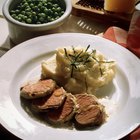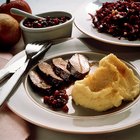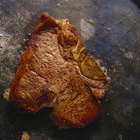
Skilled cooks understand that the tenderest meats are easy to cook but usually mild in flavor, while the toughest are among the most flavorful but require more careful cooking. The sirloin is a pleasant compromise, providing good flavor but remaining tender enough for easy cooking. That's true for venison, as well as beef or other meats. Deer sirloin isn't as tender as the loin or rib cuts, but it makes fine roasts and steaks.
Roast in the Oven
Step 1
Dry the surface of the roast with clean paper towels. Trim away any surface fat or connective tissues with the tip of a sharp knife. Venison fat can give the roast a gamy taste and isn't plentiful enough on the outside of the sirloin to provide any consistent protection against the oven's heat.
Step 2
Heat a heavy skillet over a medium-high burner, then add about half a tablespoon of oil. Sear the sirloin in the pan, browning all surfaces to create rich, savory flavors. Remove the roast to a clean tray or cutting board and season it with salt and pepper, or other flavorings as desired.
Step 3
Cover the surface of the roast with thin slices of bacon or uncured pork fat, if you like, to help prevent the roast from drying out while cooking.
Step 4
Roast the sirloin in a preheated oven at 350 degrees Fahrenheit, until it reaches the desired degree of doneness when tested with an instant-read thermometer. For rare to medium-rare venison, remove it from the oven at a temperature of 130 F to 140 F.
Step 5
Cover the roast loosely with foil and let it rest on a serving platter for 10 to 15 minutes before carving it.
Steaks on the Grill
Step 1
Scrape your grill's grate thoroughly and oil the bars. Preheat the grill to a medium-high temperature, slightly lower than you'd use for beef steaks. If you're pan-searing the venison steaks, heat a heavy skillet over medium-high heat. Don't oil the pan until you're ready to begin cooking.
Step 2
Place the steaks on your grill or in your preheated pan. Watch the line on the side of each steak, as the cooked area of the meat reaches from the surface toward the center. Turn them when the cooked portion has reached 30 to 40 percent of the steak's thickness, depending on your preferred degree of doneness. Season them lightly with salt and pepper as they cook.
Step 3
Cook the steaks for another three to five minutes on the second side, or until they're as done as you prefer. Remove them to a serving platter, and let them rest for a few minutes before serving.
Related Articles

How to Make a Blackbuck Antelope Roast

How to Cook a 15-Pound Rib Roast

How to Cook Boneless Country Spare Ribs

How to Cook Kobe Steaks

How to Cook Marinated Pork Loin From a ...

How to Cook Beef Tenderloin on a ...

How to Make a Venison Rub

How to Cook Antelope

How to Convection Roast a Brisket

How to Roast Italian Sausage

How to Cook a Breaded Thick Cube Steak

How to Cook Elk Sirloin

How to Cook Tender Rolled Flank Steaks ...

How to Cook Rib Eye Steak in an ...

How to Cook a Beef Roast in a Roaster ...

How to Cook Venison Steaks With Onions

How to Cook Deer Steaks in the Oven on ...

How to Grill a Ribeye on a Weber Q

How to Cook Axis Deer Steaks

How to Cook Churrasco Steak in a Pan
References
Tips
- Both farmed and wild-caught venison are much leaner than beef. In general, cook venison at a lower temperature than beef and for a shorter time. It's similar to grass-fed beef in its cooking characteristics, so recipes and instructional videos intended for grass-fed beef are useful when you're cooking venison.
- To give your steaks professional-looking crosshatched grill marks, place them at a diagonal as if they were pointing to 11 o'clock on an analog clock face. After 1 1/2 to 2 minutes, change the angle as if they are pointing to 7 o'clock on the clock face. Don't move the steaks again until you turn them.
- Culinarily, venison is best when served rare to medium-rare, and no more than medium. Well-done venison quickly becomes dry, and develops unpleasantly gamy or liver-like flavors. The USDA's Food Safety and Inspection service recommends cooking all meats to a minimum of 145 F and game to 160 F, which is safer but not as enjoyable to eat.
Warnings
- Wild-caught venison poses a threat of trichinosis if it's not cooked well done, so eating it rare or medium-rare is a risk. If that's how you prefer your venison, ask local wildlife authorities or a county extension agent how prevalent trichinosis is in your area and be guided by their information.
Writer Bio
Fred Decker is a trained chef and prolific freelance writer. In previous careers, he sold insurance and mutual funds, and was a longtime retailer. He was educated at Memorial University of Newfoundland and the Northern Alberta Institute of Technology. His articles have appeared on numerous home and garden sites including GoneOutdoors, TheNest and eHow.
Photo Credits
Eising/Photodisc/Getty Images